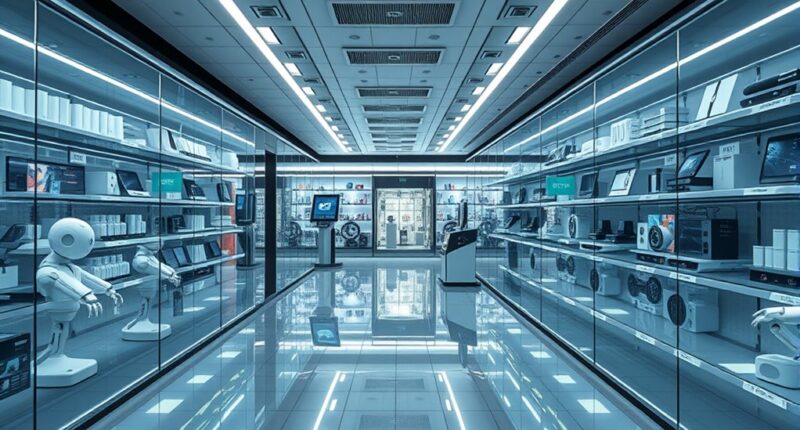The store of tomorrow is designed to operate entirely without employees by utilizing advanced automation technologies like AI, robots, and IoT systems. You’ll experience seamless checkout with mobile and contactless payments, while AI-driven inventory management guarantees products are always in stock. Robotic assistants handle tasks like stocking and customer support, creating a faster, contactless shopping environment. As these innovations grow, you’ll see stores become more efficient and personalized—discover how this transformation is unfolding.
Key Takeaways
- Retail automation uses AI, robotics, and IoT to enable stores to function independently without human staff.
- Self-checkout, mobile POS, and contactless payments allow shoppers to complete transactions seamlessly.
- Autonomous robots handle stocking, customer assistance, and security tasks, reducing the need for employees.
- Smart inventory management predicts demand, automates restocking, and minimizes stockouts without human intervention.
- Future stores will operate 24/7 with personalized experiences, significantly decreasing reliance on traditional staff.

Imagine shopping in a store where no employees are needed—just advanced technology working seamlessly behind the scenes. This isn’t a distant future; it’s rapidly becoming a reality. The retail automation market was valued at around $21.19 billion in 2023 and is projected to grow markedly, reaching approximately $36.03 billion by 2029 with a CAGR of 12.4%. Some estimates suggest it could hit $74.3 billion by 2035, expanding even faster at nearly 10% annually. North America already holds a substantial share of this market, accounting for over 38% in 2023, driven by the increasing adoption of artificial intelligence (AI), Internet of Things (IoT), robotics, and machine learning technologies in retail environments. Market Growth and Forecast The shift towards automated retail solutions is also fueled by regional investments in smart store infrastructure and technological innovation, reinforcing the trend of autonomous shopping experiences.
Your shopping experience is changing because retailers are deploying these advanced systems to automate many functions traditionally handled by employees. Rising labor costs push stores to rely more on automation to cut expenses. Omnichannel retailing, which combines online and offline shopping, demands seamless integration enabled by automation. Consumers now favor contactless and personalized experiences, prompting stores to use AI and robotics to meet these expectations. The COVID-19 pandemic accelerated this shift, with self-checkout and contactless payment systems becoming standard, reducing the need for cashier staffing and promoting safer, hygienic transactions. Operational efficiency and cost savings are crucial drivers, as automation technologies help stores run more smoothly and profitably.
You’ll notice that AI-powered inventory management systems are now predicting demand and automating restocking, keeping shelves full without human intervention. Self-checkout machines and mobile point-of-sale (POS) systems replace traditional cashiers, allowing you to scan, pay, and leave quickly. Advanced robots handle stocking, assist customers, and even provide security, all working without human oversight. Machine learning algorithms analyze your shopping habits to personalize your experience, offering tailored recommendations and promotions. Blockchain technology is also improving transparency and efficiency in supply chains, directly impacting how stores operate and ensuring products are tracked and managed effectively.
The benefits for you as a shopper are clear. Reduced wait times, faster checkouts, and improved hygiene through contactless payments enhance your overall experience. Automated inventory control minimizes stockouts and overstock issues, ensuring products are available when you need them. Stores can operate 24/7 without staffing constraints, offering greater convenience. Personalization makes shopping more engaging, with AI-driven suggestions based on your preferences. Voice-activated assistants and augmented reality tools further aid product discovery, making your journey smoother. Mobile and self-service options put control in your hands, whether shopping in-store or online, with seamless shifts between channels.
However, implementing these systems isn’t without challenges. High initial costs, integration complexities with existing systems, data privacy concerns, and regulatory compliance are hurdles retailers face. Additionally, automation may impact jobs, requiring careful management to balance technological progress with workforce needs. Looking ahead, blockchain adoption and autonomous store features are expected to grow, shaping a future where stores operate more efficiently and independently, putting more control into your hands as a shopper. [Emerging Technologies and Key Players
Frequently Asked Questions
How Do Customers Get Assistance if Needed?
When you need assistance, you’ll find automated systems ready to help. You can use AI-powered chatbots or self-service portals to get quick answers, check order statuses, or troubleshoot issues without waiting. If your question is complex, the system flags it for human follow-up. This way, you get instant support whenever you need it, with personalized help that’s efficient and accessible through multiple communication channels.
What Security Measures Are in Place Without Staff?
You’re protected by advanced security measures that operate seamlessly without staff. AI-powered cameras monitor the store floor in real time, detecting suspicious behavior and alerting remote security teams instantly. RFID and EAS systems prevent theft, while smart locks and biometric controls restrict access to sensitive areas. Remote monitoring guarantees constant vigilance, allowing security personnel to respond quickly to incidents, even when no employees are present, keeping your shopping environment safe and secure.
How Are Inventory Levels Managed Automatically?
You benefit from advanced systems that seamlessly manage inventory levels without manual input. Barcode scans, RFID tags, and IoT sensors continuously track stock movements, updating data instantly. Cloud platforms centralize information, while demand forecasting and automated reordering ensure ideal stock. Integration with sales channels and suppliers maintains accuracy, reduces errors, and prevents stockouts, allowing the store to operate efficiently and respond proactively to market needs—all automatically and effortlessly.
Can Customers Return or Exchange Items Easily?
Yes, you can return or exchange items easily. Automated systems let you initiate requests through self-service portals or kiosks, providing real-time updates on your return status. You can generate shipping labels, track your progress, and choose refunds, exchanges, or store credits—all without needing staff assistance. This streamlined process saves you time, reduces errors, and makes returns and exchanges quick, convenient, and transparent, enhancing your overall shopping experience.
What Technology Powers the Checkout Process?
Imagine walking out of the store, your items seamlessly scanned through a web of intelligent cameras, RFID tags, and sensors. The checkout process is powered by computer vision cameras that track your movements, AI algorithms matching products to your virtual cart, and RFID tech identifying items instantly. Weight sensors and intelligent shelves confirm your selections, while app-based payment systems automatically bill your account, making checkout quick, smooth, and contactless.
Conclusion
As you see, the store of tomorrow will run smoothly without employees, thanks to advanced automation and AI. Imagine a recent study showing that 70% of shoppers prefer quick, contactless checkouts—no lines, no waiting. With technology handling everything seamlessly, you’ll enjoy faster, more efficient shopping experiences. So, get ready for a future where convenience reigns, and stores operate around the clock, all without the need for staff. It’s an exciting shift you’ll want to witness firsthand.









